Wireless Security Camera Setup
In today’s connected world, keeping your home or business secure no longer requires complex wiring or professional technicians. Thanks to modern innovations, a wireless security camera can be installed quickly and managed effortlessly through your smartphone or computer. Whether you’re protecting your front porch, monitoring your office, or watching over your pets, these cameras provide unmatched convenience and flexibility.
So, what is a wireless security camera exactly? Unlike traditional wired systems that rely on long, tangled cables, a wireless security camera transmits video and audio signals over Wi-Fi or a similar wireless network. This means you can install wireless security camera units virtually anywhere within your Wi-Fi range—without drilling through walls or running messy cables. Some models, like battery powered wireless security cameras, even eliminate the need for constant power connections, offering total freedom in placement.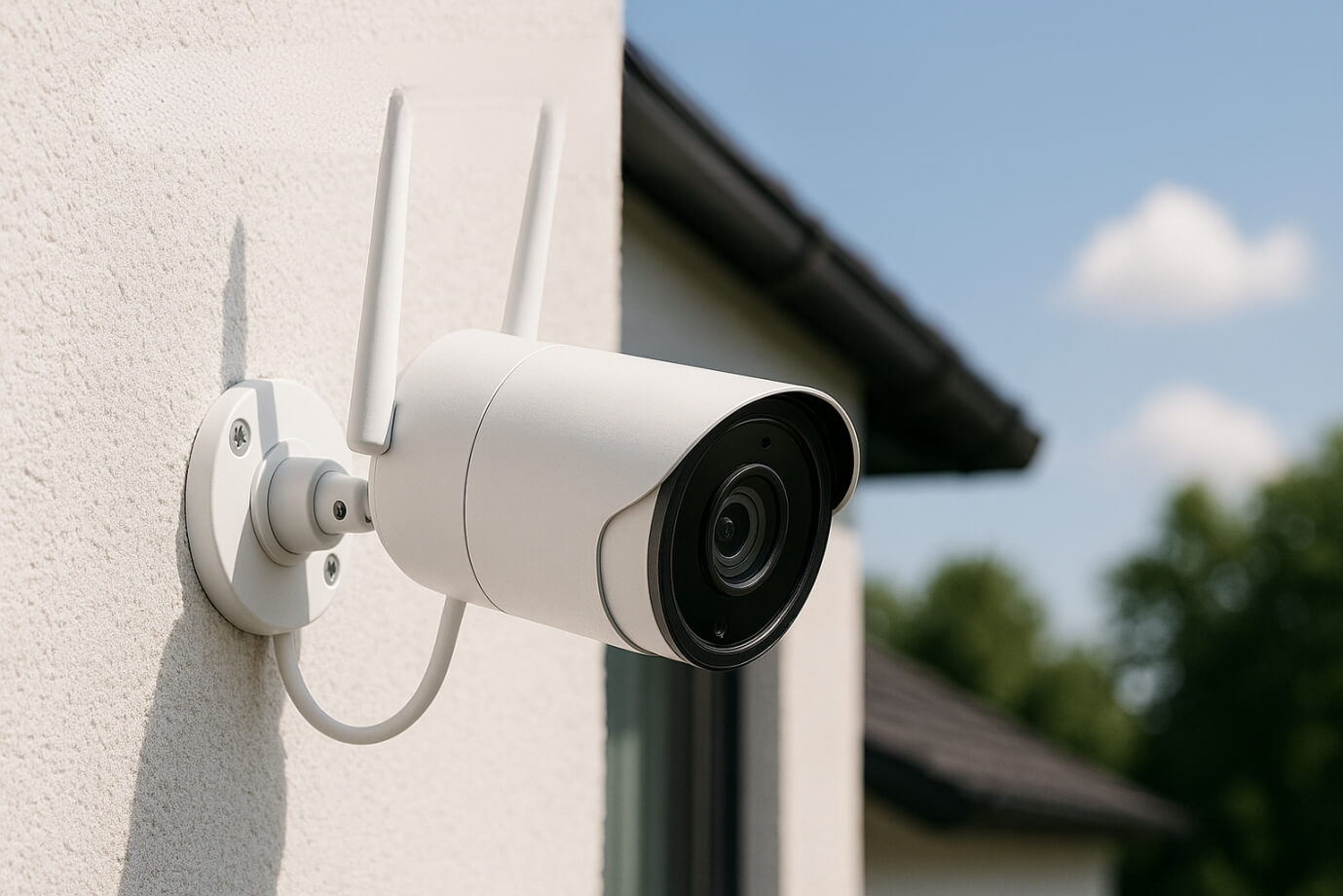
The growing popularity of wireless camera systems can be attributed to their ease of installation, cost-effectiveness, and adaptability. They have become the easiest security cameras to install, making them ideal for renters, homeowners, and small businesses alike. Setting up your own security camera for home no longer requires an expert. With the right assistance, you can set up camera systems in just a few minutes.
Today’s options go beyond basic models. You can choose from bullet cameras for outdoor monitoring, sleek indoor cams for living spaces, or advanced PTZ camera installation (Pan-Tilt-Zoom) systems that allow you to remotely control the camera’s movement and zoom in on details. If you need centralized storage and control, consider an NVR camera system setup, which connects multiple cameras into one integrated security network.
In short, wireless camera setup offers a perfect balance of simplicity and power. Whether you’re learning how to install wireless camera units for the first time or upgrading your old system, you’ll find that these modern devices deliver high-definition video, motion alerts, and cloud storage—all without the clutter of cables. As technology continues to evolve, the home security camera installation process has become smarter, faster, and more user-friendly than ever before.
Types of Wireless Security Cameras
When planning your wireless security camera setup, it’s essential to understand the different types of cameras available. Each type offers unique features suited for specific environments and installation needs. Choosing the right model can make installation easier, more reliable, and more efficient.
Indoor vs. Outdoor Cameras
- Indoor wireless security cameras are designed for monitoring rooms, hallways, and entry points inside your home. They’re compact, easy to conceal, and typically provide high-definition video with night vision. These are among the easiest security cameras to install, as they require minimal mounting and can be connected quickly through your mobile app.
- Outdoor wireless cameras, on the other hand, are built to withstand weather conditions like rain, dust, and heat. Models such as the bullet camera are popular for outdoor surveillance due to their long-range coverage and durable build. They often feature waterproof housing and infrared night vision, ensuring clear footage even in low light.
If you want to set up surveillance camera at home that covers driveways, gardens, or entry gates, outdoor cameras are your best choice. They can be easily integrated into a nvr camera system setup for centralized monitoring and recording.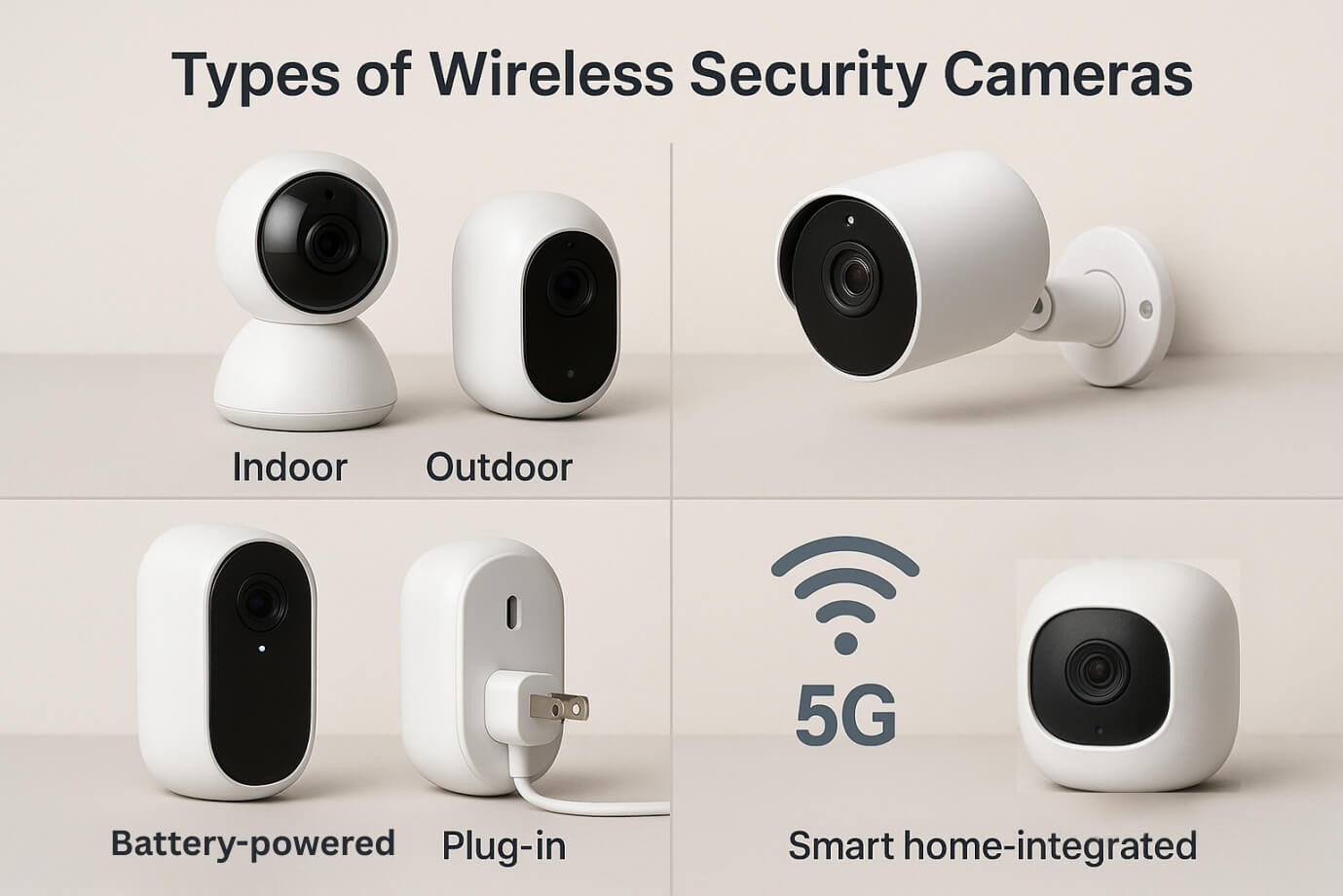
Battery-Powered vs. Plug-In Models
When choosing between battery powered and plug-in models, convenience and location flexibility are the main considerations.
- Battery-powered wireless cameras provide the freedom to place them anywhere—no wiring or nearby outlets needed. They’re ideal if you rent your home or prefer a clean installation without drilling. Many users consider them the easiest security cameras to install, since you can set up their units in minutes and move them whenever needed.
- Plug-in models, however, offer continuous power and are perfect for areas with heavy usage or high activity zones. You’ll never have to worry about recharging or battery replacement. For long-term monitoring or ptz camera installation (pan-tilt-zoom cameras), plug-in models ensure uninterrupted operation.
Wi-Fi vs. Cellular Cameras
- Most wireless security cameras rely on Wi-Fi connectivity to transmit video footage to your smartphone or network recorder. Wi-Fi cameras are ideal for homes with strong internet connections and can be easily configured through mobile apps—making the setup process straightforward.
- However, in remote areas where Wi-Fi is unstable or unavailable, cellular cameras offer a great alternative. These models use 4G or 5G SIM cards to send footage over mobile data networks, ensuring your property stays protected even without a Wi-Fi signal. They’re perfect for construction sites, cabins, or rural properties where you need to install wireless security camera units off-grid.
- When integrating multiple cameras, always consider network strength, distance, and interference to ensure smooth nvr camera system setup and uninterrupted recording.
Smart Home–Integrated Cameras
- Today’s wireless security camera systems have evolved beyond simple surveillance—they’re now an integral part of the smart home ecosystem. Smart home–integrated cameras can connect seamlessly with platforms like Google Home, Amazon Alexa, and Apple HomeKit, offering voice control, live video feeds on smart displays, and automation features.
- For example, you can say, “Hey Google, show me the front door camera,” and instantly view the feed on your display. These systems can also trigger smart lights or alarms when motion is detected, enhancing your overall home security.
- Integrating a wireless security camera with your smart devices makes it easier to manage through a single app. Whether you’re home or away, you can view footage, receive alerts, and control devices effortlessly—making smart-integrated cameras the future of home security cameras.
Selecting the right type of wireless security camera depends on your environment, power preferences, and integration needs. Understanding these options will help you install wireless security camera systems confidently and optimize your setup for long-term performance.
What You’ll Need Before Setting up Wireless Camera
Before you begin your wireless security camera setup, it’s essential to prepare the right tools, connections, and accounts to ensure a smooth installation process. Let’s explore what you need before you install wireless security camera systems for your home or office.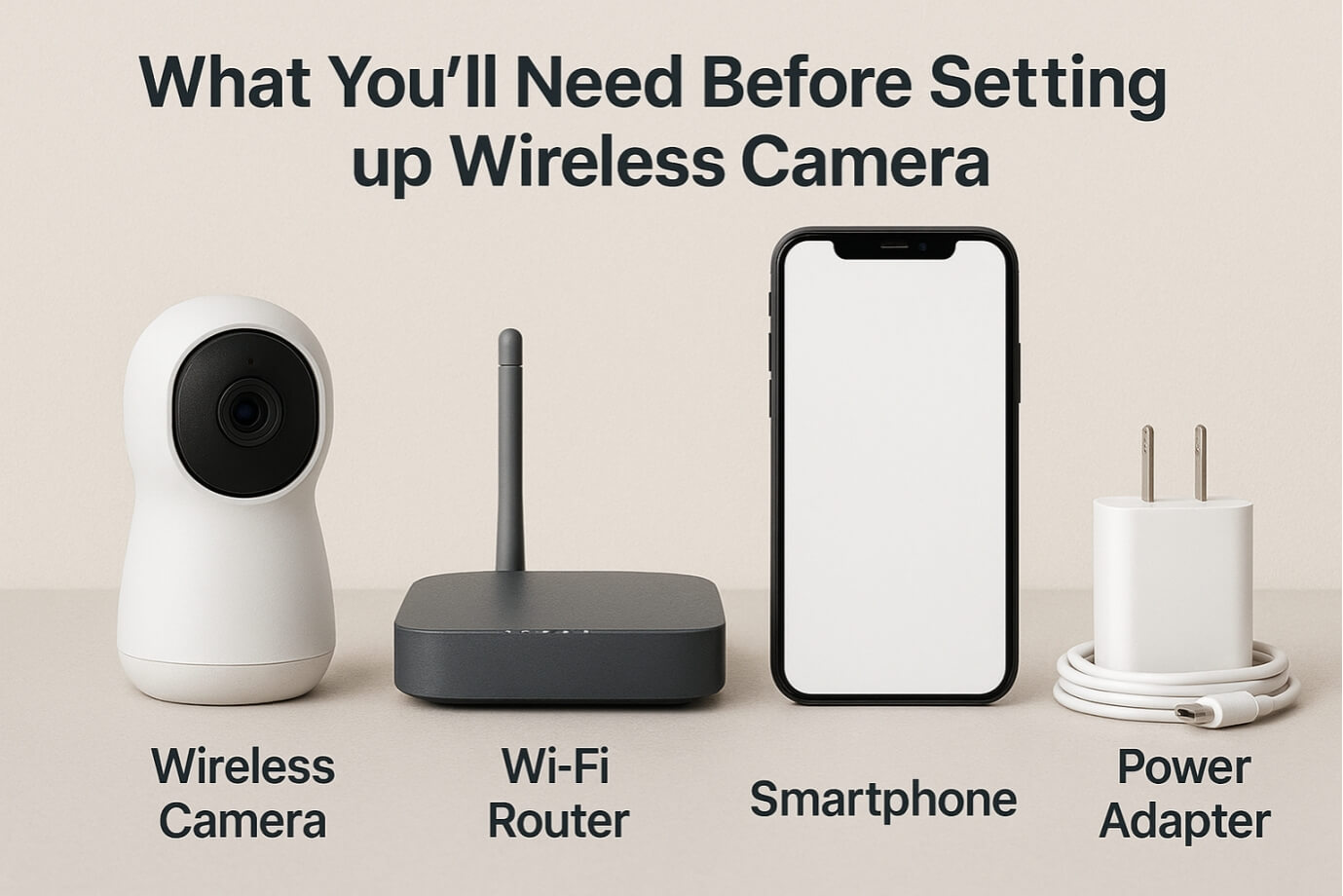
Stable Wi-Fi Connection (2.4GHz vs. 5GHz)
- A stable and strong Wi-Fi connection is the backbone of every wireless security camera Most smart cameras operate on a 2.4GHz network, which offers better range and penetration through walls, while the 5GHz band provides faster speeds but shorter range.
- Before you set up camera units, check your router’s compatibility and ensure the camera supports your chosen frequency. Many battery powered wireless security cameras and ptz camera installation models only support 2.4GHz networks, so be sure to verify this in your camera’s manual.
- If your signal strength is weak, consider using a Wi-Fi extender to maintain stable connectivity throughout your property—especially if you plan to set up surveillance camera at home in multiple areas like driveways, porches, or backyards.
Mobile App or Desktop Software
- Most modern wireless security cameras require a dedicated mobile app or desktop software for configuration. These apps help you view live feeds, receive motion alerts, and customize settings like sensitivity, resolution, and recording schedules.
- When performing your security camera setup for home, download the manufacturer’s app from the App Store or Google Play. Once installed, you can scan a QR code or manually enter your camera’s serial number to link it to your account.
- If you’re setting up multiple cameras, desktop software may offer advanced controls and storage management features. These tools also simplify cam setup when managing multiple feeds for different areas.
Power Source & Mounting Tools
- Depending on the type of wireless security camera you choose, you’ll need either a nearby power outlet or a charged battery pack. Battery powered wireless security cameras are highly flexible and can be mounted anywhere—making them the easiest security cameras to install for renters or temporary setups.
- For wired or plug-in models, make sure power outlets are within reach, or use weatherproof extension cords for outdoor bullet camera
- You’ll also need a few mounting tools for proper installation:
- Screws and anchors for wall mounting
- Drill or screwdriver
- Mounting brackets or magnetic bases (often included with cameras)
- Ensure your camera is positioned at the right height and angle for optimal coverage before finalizing your setup. For outdoor setups, angle your camera slightly downward to avoid glare and maximize field of view.
Account Setup (Cloud Storage & Privacy Settings)
- Before you install wireless security camera units, it’s important to create and configure your user account through the official camera app. This account allows you to manage multiple devices, store video recordings, and access footage remotely.
- Most camera brands offer cloud storage options for saving motion-triggered clips, while others allow local storage through microSD cards or NVR camera system setup. Cloud plans often provide additional benefits such as encrypted storage and instant playback.
- When setting up your account, review and adjust privacy settings carefully:
- Enable two-factor authentication (2FA)
- Limit access to trusted users only
- Choose whether footage is stored locally or in the cloud
- Update firmware regularly for security patches
- Taking these steps ensures your security camera installation is not only effective but also secure from unauthorized access.
Preparing your essentials before beginning the wireless security camera setup saves time and prevents technical hiccups. With a stable Wi-Fi network, the right mobile app, a proper power source, and a configured account setup, you’ll be ready to set up camera systems confidently and efficiently.
Step-by-Step Guide: How to Set Up a Wireless Security Camera
If you’ve just purchased a wireless security camera and are unsure where to start, this step-by-step section will walk you through the complete security camera setup process. Whether you’re dealing with battery powered wireless security cameras, a durable bullet camera, or an advanced PTZ camera, following these steps will ensure a smooth and successful setup.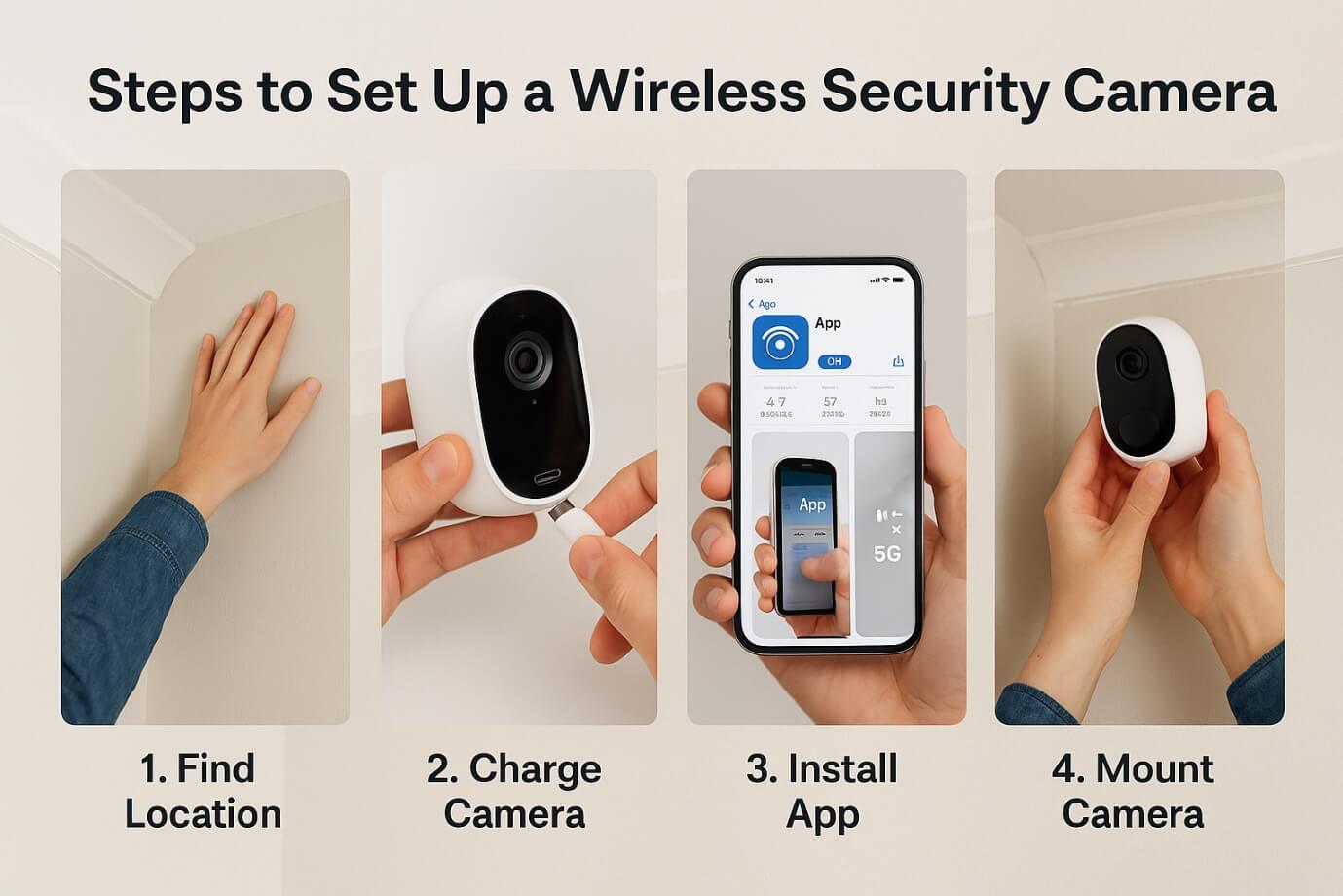
Step 1: Unbox and Check Camera Components
- Begin by unboxing your new wireless security camera and confirming that all necessary components are included. Most cameras come with:
- The main camera unit
- Mounting brackets or stands
- Power adapter or battery pack
- Screws, anchors, and user manual.
- Inspect all parts carefully to avoid missing accessories that may affect installation. A proper inventory check saves time later during your installation process.
Step 2: Power Up Your Camera
- Next, it’s time to power up your device. Depending on your model, you’ll either connect it to an outlet or insert batteries.
- For battery powered wireless security cameras, make sure the batteries are charged or replaced as needed. Many of these models feature built-in LED indicators that show when the device is ready for pairing.
- Powering up properly ensures your cam setup goes smoothly once you move on to connectivity.
Step 3: Connect to Wi-Fi via App or QR Code
- Now comes the most crucial step in your setup — connecting your wireless security camera to your home network.
- Download the manufacturer’s mobile app or install the desktop software recommended in the manual. Most apps will guide you through a simple process:
- Open the app and create a user account.
- Choose “Add Device” or “Set Up New Camera.”
- Scan the QR code printed on your camera or enter the serial number.
- Select your Wi-Fi network and enter the password.
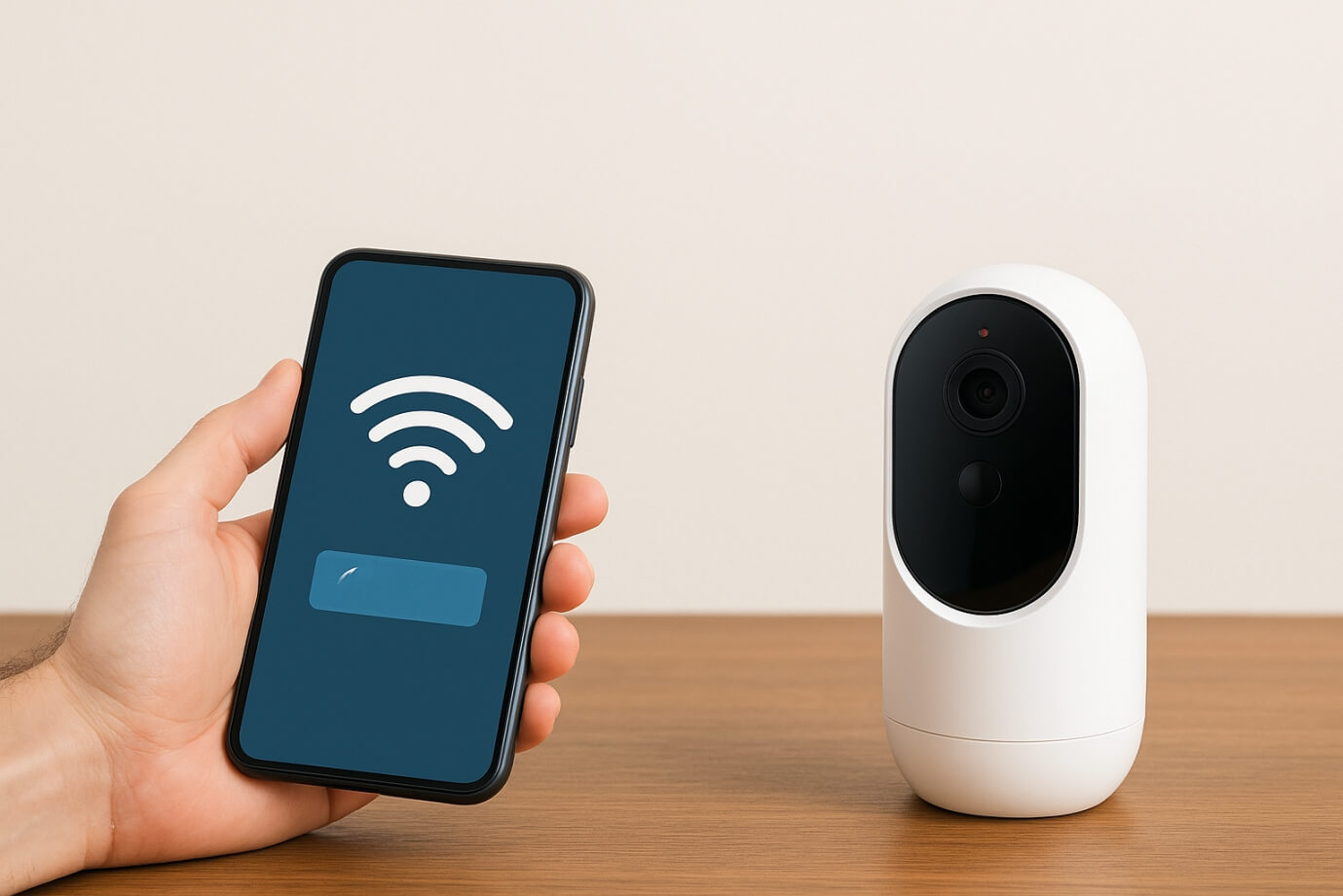
- Ensure your camera is within range of your router. Most wireless security cameras connect best to 4GHz networks for longer range and stable signals.
- Once connected, you’ll see your camera appear in the app interface — confirming that your installation process is successful.
Step 4: Configure Camera Settings (Motion Detection, Alerts, Video Quality)
- With your device online, it’s time to customize your wireless security camera setup for home according to your preferences.
- Within the app, navigate to the settings panel to adjust the following:
- Motion Detection Sensitivity: Fine-tune how your wireless security camera detects movement. Higher sensitivity captures more activity but may trigger false alarms.
- Notification Alerts: Enable real-time push notifications to your smartphone for motion events.
- Video Quality: Choose HD or Full HD streaming, depending on your internet speed.
- Recording Schedule: Set specific times for recording or continuous monitoring.
- If you have an NVR camera system setup, you can configure storage settings and manage multiple cameras from a central interface.
- Proper configuration ensures that your wireless security camera captures clear footage and sends timely alerts, keeping your property protected 24/7.
Step 5: Mount or Position Your Camera Strategically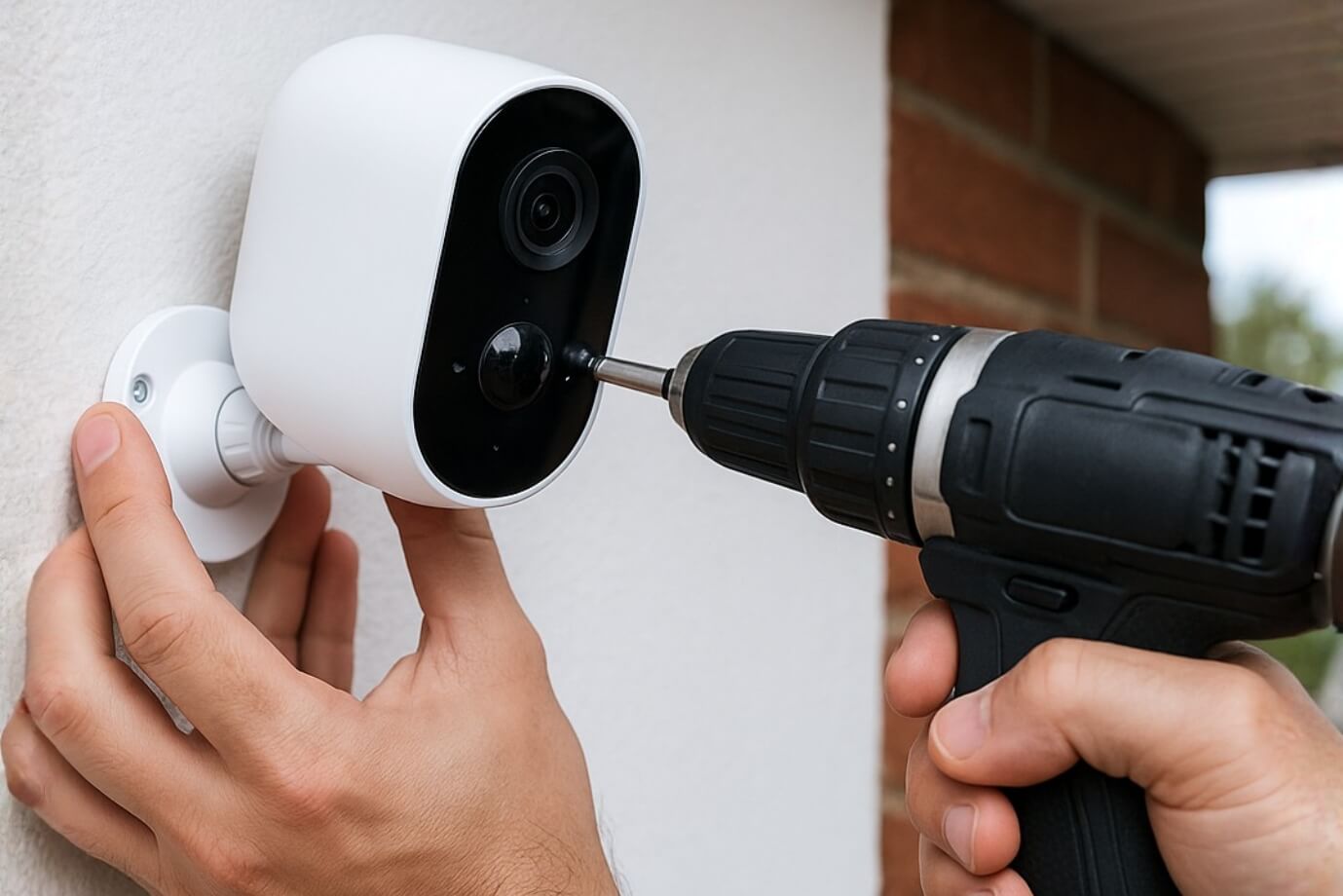
- Now it’s time to physically set up camera The effectiveness of your security camera setup depends heavily on where and how you mount it.
- Indoor placement: Position cameras at entryways, hallways, or high-traffic areas. Avoid pointing directly at bright windows to prevent glare.
- Outdoor placement: Mount bullet cameras under eaves or rooflines for weather protection. Use the included hardware to secure the camera firmly.
- Height and angle: Install cameras 7–10 feet off the ground and slightly tilted downward for optimal field of view.
- PTZ camera installation: For advanced models, use the pan-tilt-zoom controls to adjust angles remotely.
- When mounting battery powered wireless security cameras, ensure they’re easily accessible for recharging or battery replacement. For wired models, hide cables neatly to prevent tampering and maintain a clean look.
Step 6: Test the Live Feed and Troubleshoot
- Once your cam setup is complete, it’s time to test everything. Open the app or desktop software to view your live feed. Check for clear visuals, responsive motion alerts, and proper audio functionality.
- If you encounter issues such as lag, connection drops, or poor image quality, try these quick fixes:
- Move the camera closer to the router
- Reboot your device
- Check Wi-Fi signal strength
- Update firmware via the app
- Reset the camera and repeat the pairing process
- Testing ensures that your wireless security camera setup is reliable before you rely on it for daily monitoring.
- When all tests pass, congratulations — you’ve successfully completed your installation and can now enjoy a fully functional smart surveillance system!
Setting up a wireless security camera doesn’t have to be complicated. With proper preparation, the right tools, and this step-by-step guide, wireless security camera can be installed properly.
Troubleshooting Common Wireless Security Camera Issues
Even the most advanced wireless security camera can occasionally experience technical glitches. From Wi-Fi connectivity issues to lagging video feeds, these problems are quite common — and fortunately, easy to fix. Let’s go through the most common issues users face and how to resolve them step by step.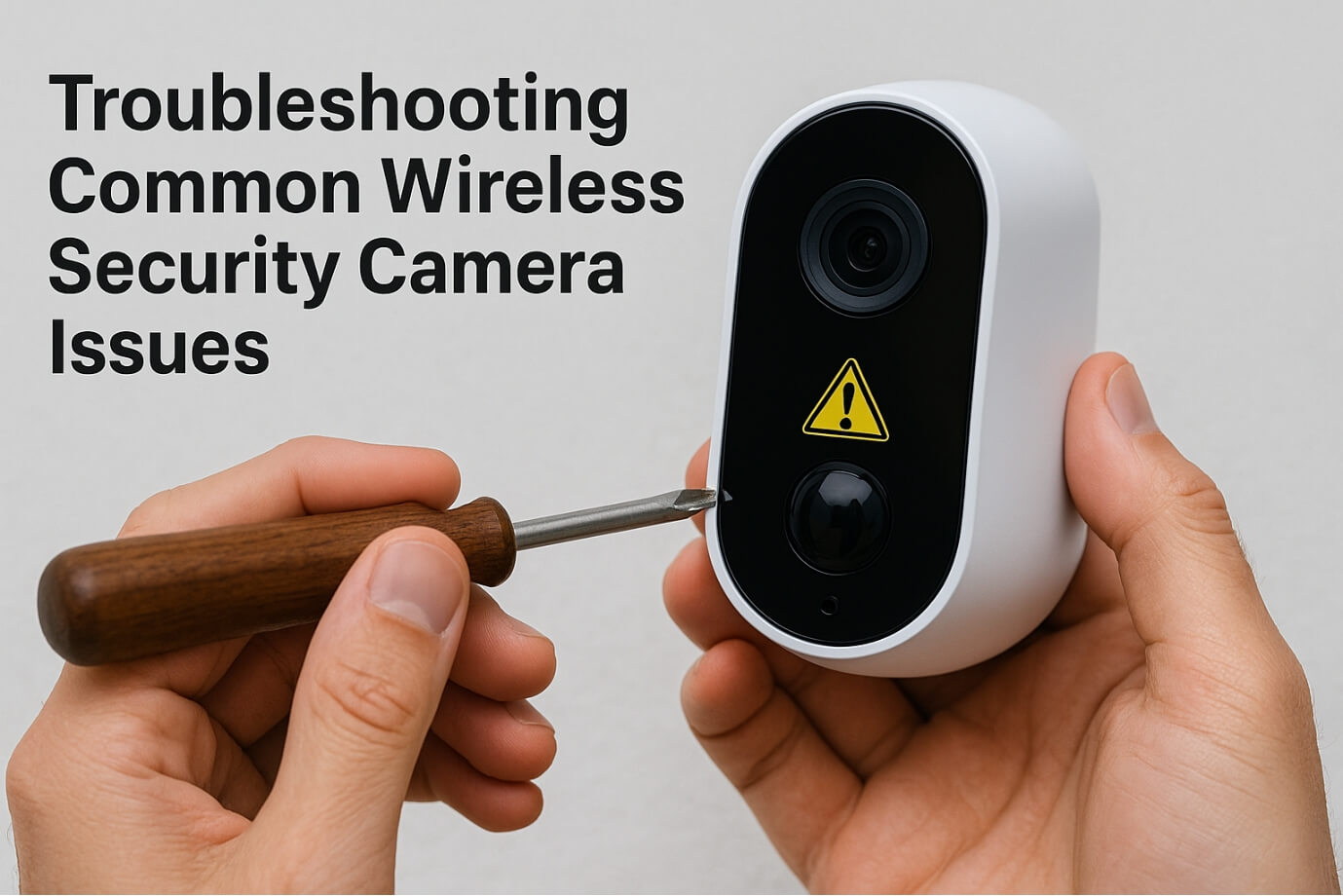
Camera Not Connecting to Wi-Fi
A failed Wi-Fi connection is one of the most frequent problems in any wireless security camera installation. This can happen due to weak signals, incorrect passwords, or compatibility issues.
How to Fix It
- Check Wi-Fi Frequency: Most wireless security cameras only support 2.4GHz networks. If your router is set to 5GHz, switch to 2.4GHz for better range and connectivity.
- Reduce Distance: Ensure your camera is within 10–15 feet of the router during initial camera setup. You can reposition the device after a successful connection.
- Reset Network Credentials: Re-enter your Wi-Fi password in the app and verify that there are no typos or spaces.
- Reboot Devices: Restart both the camera and router to clear any network cache.
If you install wireless security camera units outdoors, you may need a Wi-Fi extender or mesh system to boost the signal range. Maintaining a strong connection is critical, especially for multi-camera systems or PTZ camera setups.
Video Feed Lag or Buffering
Another common issue during wireless security camera installation is delayed or choppy video streams. This typically points to bandwidth or signal strength problems rather than camera defects.
How to Fix It
- Check Internet Speed: Your network should offer at least 2–5 Mbps upload speed per camera for smooth HD streaming.
- Reduce Resolution: Lower video quality settings in your app to prevent buffering during low bandwidth periods.
- Move Closer to Router: If possible, place your wireless security camera closer to the access point or remove physical obstructions.
- Limit Devices: Too many devices connected to your network can slow down performance. Disconnect unused gadgets to free up bandwidth.
If you’re running a complex nvr camera system setup, consider using a wired connection between your NVR and router for consistent streaming while keeping your cameras wireless for flexible positioning.
Motion Detection Not Working
When your wireless security camera fails to trigger alerts or record movement, it’s usually due to incorrect settings or environmental factors.
How to Fix It
- Check Motion Zones: Open the app and ensure that motion detection zones are properly defined. Avoid excluding key areas accidentally.
- Adjust Sensitivity: Increase motion sensitivity for large open areas or decrease it in busy zones to avoid false triggers.
- Clean the Lens: Dirt or condensation on your bullet camera or PTZ camera lens can interfere with sensors.
- Enable Notifications: Ensure that app notifications are turned on for your user account and that Do Not Disturb mode isn’t active.
For battery powered wireless security cameras, remember that motion detection may be disabled in power-saving mode. Adjust the settings to prioritize performance if you notice missed events during your cam setup.
App Connection Problems
App-related issues can disrupt the user experience even if your wireless security camera setup works fine technically. Common app problems include login failures, blank screens, or syncing errors.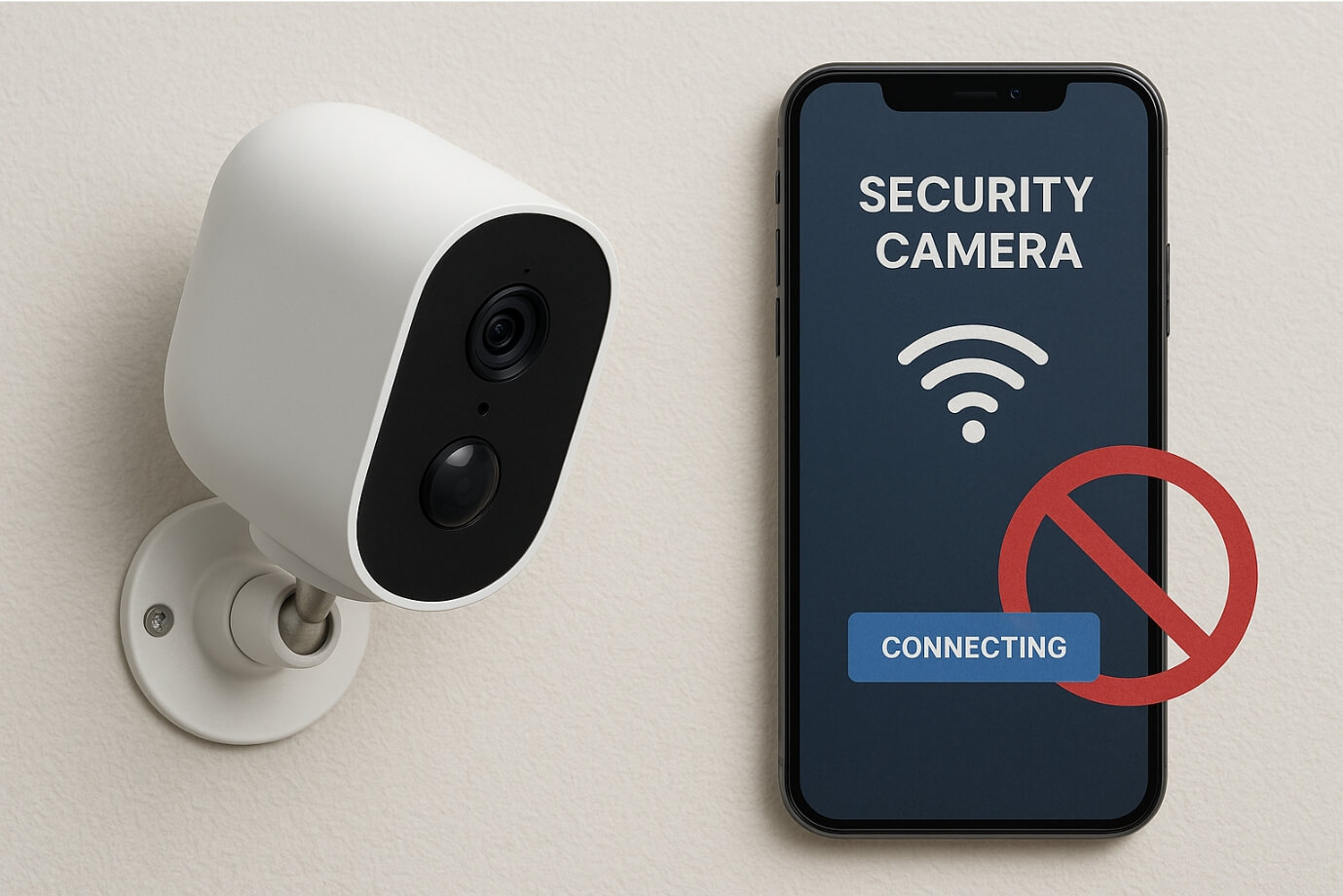
How to Fix It
- Update the App: Check the Play Store or App Store for updates. Outdated versions often contain bugs that affect connectivity.
- Reinstall the App: Uninstall and reinstall to clear cached data that might be causing conflicts.
- Check Permissions: Allow the app access to Wi-Fi, location, and notifications to enable full functionality.
- Verify Account Credentials: Ensure you’re logging into the correct account associated with your wireless security camera.
For advanced systems like nvr camera system setup, desktop software may offer a more stable connection than mobile apps, especially when managing multiple cameras simultaneously.
Resetting Your Wireless Security Camera
If all else fails, performing a factory reset can solve persistent connectivity or performance issues.
How to Reset
- Locate the reset button on your security camera — usually near the power port or under a removable panel.
- Press and hold the button for 10–15 seconds (refer to the manual for exact duration).
- Wait for indicator lights to flash or hear a beep confirming the reset.
- Reopen your app and repeat the installation steps to reconfigure the device.
This process restores your wireless camera setup to its original settings, clearing out corrupted configurations or outdated Wi-Fi details. However, you’ll need to set up camera preferences, such as motion alerts and cloud storage, again after resetting.
By following these troubleshooting steps, you can ensure your installation stays connected, responsive, and secure.
Best Practices for Wireless Camera Security
Once your security camera setup is complete, the next critical step is securing your system against unauthorized access. Whether you’ve installed a single wireless security camera, multiple battery powered wireless security cameras, or a professional nvr camera system setup, strong security practices are essential to protect your footage and maintain your privacy.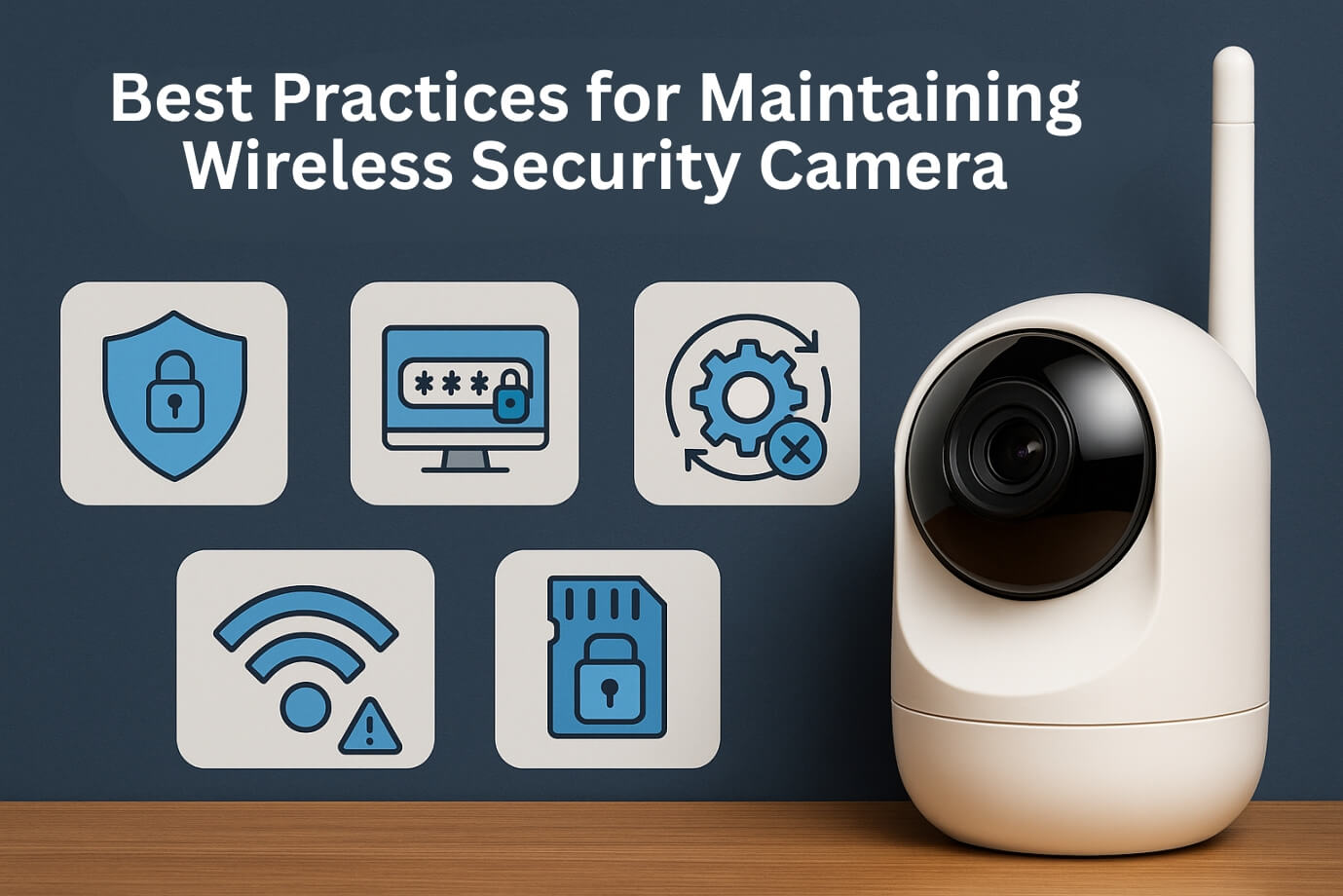
In this section, we’ll go over the most effective ways to safeguard your home security camera installation and keep your surveillance system safe from potential breaches.
Use Strong Passwords and Enable Two-Factor Authentication (2FA)
The simplest yet most powerful way to protect your wireless security camera system is by creating strong, unique passwords. Many homeowners overlook this step, leaving their devices vulnerable to hacking attempts.
Here’s how to strengthen your password security:
- Use a mix of uppercase and lowercase letters, numbers, and special symbols.
- Avoid using common passwords like “admin” or “123456.”
- Don’t reuse passwords across multiple devices or accounts.
For extra protection, always enable Two-Factor Authentication (2FA) on your camera app or control panel. This adds a second layer of defense by requiring a code sent to your mobile phone or email before anyone can log in.
When you set up camera access for multiple users, assign individual accounts instead of sharing one login to keep activity traceable and secure.
Keep Firmware Up to Date
Firmware updates are crucial for maintaining the performance and security of your wireless security camera system. Manufacturers regularly release updates to patch vulnerabilities, enhance functionality, and improve stability.
If you skip firmware updates, your security camera setup could be exposed to outdated protocols or security flaws that hackers may exploit.
Here’s what to do:
- Check your camera app or dashboard regularly for new firmware notifications.
- Enable automatic updates if your system supports it.
- Reboot your camera after each update to apply new security patches effectively.
Whether you’re managing a single battery powered wireless security camera or a large nvr camera system setup, staying up to date ensures your network remains protected and your video feeds remain private.
Set Up a Secure Wi-Fi Network
Your wireless security camera relies on Wi-Fi to transmit footage — which means your home network’s security directly impacts your camera’s safety.
Follow these best practices to strengthen your Wi-Fi protection:
- Change your router’s default credentials immediately after installation.
- Use WPA3 encryption (or WPA2 if WPA3 isn’t supported) for the highest level of wireless protection.
- Hide your SSID (network name) to prevent unauthorized users from easily identifying your network.
- Use a strong, unique password different from your camera login.
- Create a separate Wi-Fi network for your security camera setup — this isolates your cameras from other smart devices like TVs and phones, reducing exposure risks.
For users who install wireless security camera systems across large properties, consider using mesh Wi-Fi with built-in security features. These networks not only improve range but also protect your cam setup against intrusion attempts.
A secure Wi-Fi network is the foundation of every reliable home security camera installation and ensures uninterrupted, encrypted communication between your cameras and cloud services.
Manage Cloud Storage Safely
Many modern wireless security cameras use cloud storage to store recorded footage. While convenient, it’s vital to manage cloud access carefully to prevent leaks or unauthorized viewing.
Follow these safety tips for secure cloud management:
- Always choose reputable brands and storage providers that offer end-to-end encryption.
- Review the provider’s privacy policy — ensure they don’t share your footage with third parties.
- Use two-factor authentication for your cloud account.
- Regularly delete outdated or unnecessary clips to minimize data exposure.
- Avoid logging into your cloud account from public or unsecured Wi-Fi networks.
By implementing these steps, you’ll ensure that your cam setup remains safe, your data stays private, and your home remains protected 24/7 — exactly what every home security camera installation should guarantee.
FAQs
Q. What is a wireless security camera and how does it work?
- A. A wireless security camera is a modern surveillance device that transmits video footage over Wi-Fi instead of traditional wired connections. It connects to your router and streams live video directly to your smartphone or computer through a mobile app. This type of camera setup eliminates the need for complex wiring, making it ideal for quick and flexible installations in both homes and offices.
Q. Are battery powered wireless security cameras reliable for long-term use?
- A. Yes, battery powered wireless security cameras are highly reliable and perfect for users who prefer flexibility and easy placement. They’re among the easiest security cameras to install, requiring no cables or power outlets. Battery life varies by model but typically lasts several months on a single charge. For best results, use power-saving modes and recharge or replace batteries regularly.
Q. What’s the difference between a bullet camera and a PTZ camera installation?
- A. A bullet camera is a fixed-lens outdoor camera with a long, cylindrical design, ideal for covering specific areas like entrances or driveways. A PTZ camera (Pan-Tilt-Zoom) offers remote control for movement and zoom, allowing you to monitor wider spaces dynamically. Both types can be integrated into your nvr camera system setup for complete coverage and easy management.
Q. How do I install wireless security camera systems at home?
- A. To install wireless security camera systems, start by unboxing and powering up your device, then connect it to your Wi-Fi network using the mobile app or QR code. Next, configure settings such as motion detection, alerts, and video resolution. Finally, mount your camera securely and test the live feed. These steps make home security camera installation simple even for first-time users.
Q. What should I do if my camera won’t connect to Wi-Fi during setup?
- A. If your wireless security camera isn’t connecting to Wi-Fi, first ensure you’re using a 2.4GHz network, as many cameras don’t support 5GHz bands. Move the camera closer to the router and re-enter your Wi-Fi password carefully. Restart both the router and camera, and try again. These troubleshooting steps typically resolve most security camera setup connectivity issues.
Q. How can I improve the range and performance of my camera setup?
- A. To boost the performance of your cam setup, position your router centrally and minimize obstacles like walls and metal objects. Consider using Wi-Fi extenders or a mesh system to increase coverage. Adjusting your camera’s antenna and ensuring strong signal strength can greatly enhance the reliability of your wireless security camera feed, especially in larger homes.
Q. Is cloud or local storage better for a security camera setup for home?
- A. Both options have advantages. Cloud storage provides easy remote access and automatic backups, while local storage using an nvr camera system setup or SD card offers more control and privacy. Many users prefer a hybrid approach — storing important clips in the cloud and keeping continuous recordings locally for complete data protection in their security camera setup for home.
Q. How do I ensure my wireless camera system is secure from hackers?
- A. To secure your wireless security camera, always use strong, unique passwords and enable two-factor authentication on your account. Regularly update your camera’s firmware to fix security vulnerabilities and use WPA3 encryption on your Wi-Fi network. Keeping your wireless security camera system updated and encrypted helps prevent unauthorized access.
Conclusion
Setting up a wireless security camera system is one of the smartest investments you can make for home or business protection. However, the success of your installation depends on how well you plan, configure, and secure your devices. Whether you’re using battery powered wireless security cameras, a durable bullet camera, or managing a complete nvr camera system setup, each step plays a vital role in ensuring long-term reliability and security. With the right approach, even beginners can achieve professional results and enjoy peace of mind through a stable and secure setup.
Throughout this blog, we’ve covered every essential step for a successful home security camera installation. From understanding camera types and Wi-Fi setup to configuring storage and ensuring data security, the process of install wireless security camera systems has become more intuitive than ever. Choosing the right model—whether a flexible PTZ camera or compact indoor option—sets the foundation for effective monitoring. Preparing a strong Wi-Fi network, downloading the companion app, and organizing your mounting tools ensures that your camera setup runs smoothly from start to finish.
Once your cameras are powered and connected, positioning them strategically is key. Outdoor bullet cameras should be mounted high for maximum visibility, while battery powered wireless security cameras should be placed where battery access is easy. Configuring alerts, motion sensitivity, and video quality helps you set up camera systems tailored to your specific needs. Integrating your system with cloud or local storage, such as through an nvr camera system setup, allows you to manage and access footage safely from anywhere, ensuring round-the-clock security.
Of course, security doesn’t end with installation—it’s an ongoing process. Protecting your system against unauthorized access is vital to keeping your data and footage safe. Always use strong passwords, enable two-factor authentication, and update your firmware regularly. These steps strengthen the protection of your security camera setup and prevent hacking attempts or data breaches. Additionally, securing your Wi-Fi with encryption and managing cloud storage carefully will make your entire cam setup more resilient. A secure configuration is what transforms an ordinary system into a reliable home defense network.
Ultimately, modern wireless security cameras are designed to make surveillance simple and accessible. They are among the easiest security cameras to install, giving homeowners the flexibility to set up surveillance at home. Still, the real difference lies in how well you maintain, secure, and optimize your system after installation. Whether you’re a first-time user learning how to install wireless camera devices, careful planning and attention to detail ensure maximum performance.
Even with the easiest security cameras to install, not every setup goes perfectly the first time. You might experience weak Wi-Fi signals, video buffering, or syncing problems while learning how to install wireless cameras. If that happens, don’t stress — our experienced professionals are here to help with your camera setup for home or office.
For more information, go to our Homepage.

